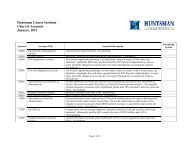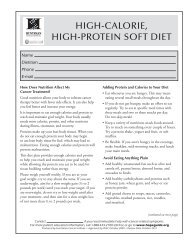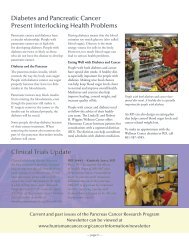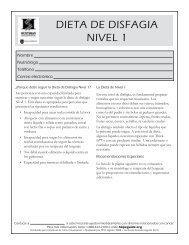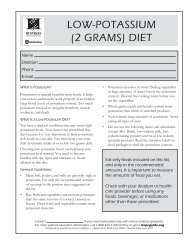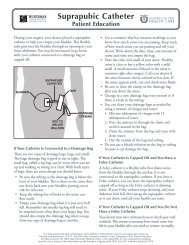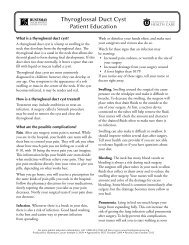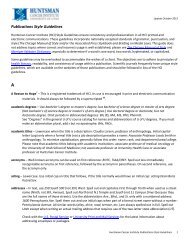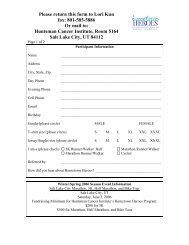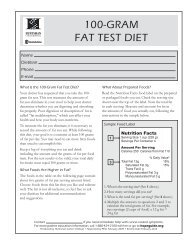Huntsman Cancer Institute Style Manual
Huntsman Cancer Institute Style Manual
Huntsman Cancer Institute Style Manual
You also want an ePaper? Increase the reach of your titles
YUMPU automatically turns print PDFs into web optimized ePapers that Google loves.
Updated July 15, 2009<strong>Huntsman</strong> <strong>Cancer</strong> <strong>Institute</strong> Publications <strong>Style</strong> Guidelines<strong>Huntsman</strong> <strong>Cancer</strong> <strong>Institute</strong> (HCI) <strong>Style</strong> Guidelines ensure consistency and professionalism in all HCI printed orelectronic communications. These guidelines incorporate nationally accepted standards of grammar,punctuation, and style (The Chicago <strong>Manual</strong> of <strong>Style</strong> and/or the Associated Press <strong>Style</strong>book and Briefing onMedia Law). This guide does not address topics where correct and incorrect usage is well established; please seeThe Chicago <strong>Manual</strong> of <strong>Style</strong> and Merriam‐Webster Dictionary, especially to determine if a word is one word,two words, hyphenated, or capitalized. Additional reference books, including medical dictionaries, style andusage guides, and The Gregg Reference <strong>Manual</strong>, are available for review in the Office of Communications.Some guidelines may be overlooked to accommodate the wishes of a client. The objectives are readability andconsistency of usage within a publication. Scientific journals frequently have unique style guidelines, which areavailable on the websites of those publications and should be followed in lieu of the HCI guidelines.AA Reason to Hope ® – This is a registered trademark of HCI. Its use is encouraged in print and electroniccommunication materials. It should always be followed by a superscripted ®.academic degrees – Use bachelor’s degree or master’s degree, but bachelor of science degree or master of artsdegree. (Not bachelor’s of science degree or master’s of arts degree.) Use doctoral degree or doctorate,but not doctorate degree. Omit periods in abbreviated degrees: BA, BS, MA, MS, PhD, PharmD.See “Degrees” in the general U of U course catalog for names and abbreviations of U of U degrees. If youmust make an abbreviation plural, add s but no apostrophe: BAs, PhDs.academic titles – Lowercase when the title is a description: Claudio Larsen, professor of anthropology. Initialcapital letter (cap) only when a formal title (not a job description) precedes a name: Associate ProfessorJacob Smith in anthropology. To minimize capitalization, generally follow this order: name, rank, anddepartment/area/college. Please note that academic titles belong with academic institutions: associateprofessor of medical oncology at the University of Utah School of Medicine; not associate professor atUniversity Health Care or associate professor at <strong>Huntsman</strong> <strong>Cancer</strong> <strong>Institute</strong>.acronyms – Well‐known acronyms can be used on first reference: ROTC, TIAA/CREF. Spell out less immediatelyrecognizable acronyms on first reference, followed by the acronym in parentheses. On secondreference, use the acronym only.acting – Lowercase. Use initial cap on title that follows, if the title normally would have an initial cap: actingDean Boris Kuznetsov.addresses – In text, use 250 South 500 (not 5th) West. Spell out and capitalize First through Tenth when used asa street name (Ninth, not 9th, Avenue). Spell out North (not N.) Temple and South (not S.) Campus Drive(because they are the full names of those streets). Use the abbreviations Ave., Blvd., and St. only with anumbered address: 1600 Pennsylvania Ave. Spell them out and use initial caps when part of a formalstreet name without a number: Pennsylvania Avenue. All similar words (alley, drive, road, terrace, etc.)are always spelled out in full. Spell out Utah except when writing an actual mailing address that requiresuse of the two‐letter state abbreviation (UT).<strong>Huntsman</strong> <strong>Cancer</strong> <strong>Institute</strong> Publications <strong>Style</strong> Guide 1
All U of U mailing addresses printed on anything that must be physically read by U.S. Postal Servicemachines (e.g., a preaddressed return envelope) must be all uppercase, use a sans‐serif font (e.g., Arial),lack articles or conjunctions, include a street address, use standard postal abbreviations, and (for ZIPcode 84112) include a four‐digit extension to the ZIP code. The campus directory contains a list of U of Udepartmental mailing addresses. Example:JANE JONESEDITORUNIVERSITY OF UTAHPRINTING SERVICES1795 E SOUTH CAMPUS DR RM 135SALT LAKE CITY UT 84112‐9400When writing an office’s mailing address in text (i.e., NOT when writing for a preaddressed envelope oranything else where a postal machine might “read” it), it is acceptable to use both uppercase andlowercase, commas, periods, conjunctions, articles, and any font you choose in order to make theaddress legible and expressive of your particular program or office. So, the above address could bewritten in a brochure, for example, as:Jane Jones, EditorUniversity of UtahPrinting Services1795 E. South Campus Dr., Rm. 135Salt Lake City, Utah 84112‐9400If the audience is external to the U of U and there’s any chance that readers will need to know themailing address, then include it in the publication. If an audience is purely internal and campus mailwould likely be the only means of response, then the room number and building name may besufficient. Thus, the above Printing Services address could be written for an internal audience as 135University Services Building. Often in publications it is advisable to include BOTH the mailing address andthe campus location, with the mailing address clearly designated as such.administration – Lowercase: the central administration, the Machen administration.adviser – Not with an ‐or.African American – No hyphen. See Black or African American entry.AIDS – All uppercase because it’s an acronym. Not necessary to spell out on first reference. See also HIV entry.AirMed – One word, with uppercase M.Alaskan Native – Initial caps. Term for racial/ethnic group used by the U.S. government and the U of U’s Officeof Equal Opportunity and Affirmative Action.alma mater – Lowercase.alumni, alum – Use alumnus (singular male); alumna (singular female); alumni (plural male or plural of bothgenders); alumnae (plural female). Alum, alums are informal unisex terms.<strong>Huntsman</strong> <strong>Cancer</strong> <strong>Institute</strong> Publications <strong>Style</strong> Guide 2
When identifying University alumni, use degree and class year (without periods in the degreeabbreviations, without commas around the degrees, and without a space between the degree and yearabbreviations): LaDawn Smith Jones BA’60 MA’63; Martin Gomez BS’75 PhD’80. Note the direction ofthe apostrophe. When it’s not possible to find out a person’s degree, use just the class year—the firstclass year in the case of multiple degrees: Darnell Harris ’75. See also degrees entry.To aid recognition of a married alumna, use the married and maiden names, if appropriate: LaDawnSmith Jones BA’60 MA’63.a.m., p.m. – Lowercase, with periods but no spaces. When writing 12 p.m., use “noon”; 12 a.m. use “midnight,”but not “12 noon” or “12 midnight.” If the time is on the hour, do not include :00 with the hour whenusing a.m. or p.m.: use “5 p.m.” not “5:00 p.m.” Obviously, when the time is not on the hour, the colonand minutes should be included: “2:35 a.m.”American Indian – Initial caps. Term for racial/ethnic group used by the U.S. government and the U of U’s Officeof Equal Opportunity and Affirmative Action.ampersand (&) – Use only when it is part of an organization’s formal name; otherwise, use and in text. Not used,for example, in full names of U of U departments.archaeology – Not archeology.Asian – Initial cap. Term for racial/ethnic group used by the U.S. government and the U of U’s Office of EqualOpportunity and Affirmative Action. Also, Asian is preferred over Oriental for inhabitants of the Far Eastnations of Asia and nearby islands.associate degree – Not associate’s degree (unlike bachelor’s below).attribution – Use present tense (he says, she says) unless the reference is specifically time‐related.Bbachelor’s – Use an apostrophe (possessive) when referring to the degree: bachelor’s program, bachelor’sdegree, a bachelor’s in communication.Black or African American – Initial caps. Term (all four words as a unit) for racial/ethnic group used by the U.S.government and the U of U’s Office of Equal Opportunity and Affirmative Action.Board of Trustees, Board of Regents – Lowercase on second reference when omitting board: to the trustees,from the regents.breast self‐examination – see self‐examination entry.<strong>Huntsman</strong> <strong>Cancer</strong> <strong>Institute</strong> Publications <strong>Style</strong> Guide 3
usiness letters – standard format for business letters on HCI letterhead should be as follows:CDate###Mr./Ms. First Name Last NameTitleBusiness NameMailing AddressCity, State ZIP Code#Dear Mr./Ms. Last Name:#This letter contains standard format guidelines for <strong>Huntsman</strong> <strong>Cancer</strong> <strong>Institute</strong> correspondence.#Margins should be set as follows: one‐inch top margin (or more to adjust the body of the letter on the page), twoinchleft margin, one‐inch right and bottom margins.#Paragraphs should be typed single‐spaced with no indentations. The pound signs designate number of spacesbetween paragraphs or lines.#Sincerely,###NameTitle#Enclosure(s) number of enclosures may be included#cc: Sue Jones (cc should not be capitalized, if sending to more than one person, line names up vertically with firstinitial)(This is the heading format for second, and subsequent, pages.)(begin header one inch from top)First Name Last NameDatePage Number#Continue correspondence on this line. (If more than one page is required, closing and signature line illustratedabove should appear on final page.)capitalization – Avoid unnecessary capital letters. Too many capitals detract from your message by slowing anddistracting the reader. Use a capital letter only when principles in this style guide or other referencesjustify doing so. See professional titles entry.Caucasian – Initial cap. Term for racial/ethnic group used by the U.S. government and the U of U’s Office ofEqual Opportunity and Affirmative Action.<strong>Huntsman</strong> <strong>Cancer</strong> <strong>Institute</strong> Publications <strong>Style</strong> Guide 4
Department and program names – Spell out and initial cap the proper names of all HCI departments andprograms on the first reference within a document. If a department or program name will be referencedmore than once, include the acronym within parentheses, and use the acronym for subsequentreferences. For example, <strong>Huntsman</strong> <strong>Cancer</strong> Information Service (HCIS).The following are formal departments and programs within HCI:<strong>Cancer</strong> Center Support Grant (CCSG) Programs<strong>Cancer</strong> Control and Population Sciences (CCPS)Cell Response and Regulation (CRR)Gastrointestinal <strong>Cancer</strong>s (GIC)Imaging, Diagnostics, and Therapeutics (IDT)Nuclear Control of Cell Growth and Differentiation (NC)<strong>Cancer</strong> Control and Population Sciences ProgramPedigree and Population Resource GroupCenter for Children’s <strong>Cancer</strong> ResearchClinical Trials Office (CTO)Colon ProgramCommunications and Public Affairs, Office ofPrint CommunicationsWeb CommunicationsComputing and Technology Group (CATG)Director’s Translational Research Initiative (DTRI)Facilities and OperationsFamilial Colon <strong>Cancer</strong> Registry (FCCR)Familial Colon <strong>Cancer</strong> Research Clinic (FCCRC)Familial Colon <strong>Cancer</strong> Study (FCCS)Familial Melanoma Research Clinic (FMRC) – properly referred to as The Tom C. Mathews Jr.Familial Melanoma Research ClinicFamily <strong>Cancer</strong> Assessment Clinic (FCAC)Finance DepartmentGeneral AdministrationHigh Risk Breast <strong>Cancer</strong> Clinic (HRBCC) – (do not hyphen high‐risk)High Risk <strong>Cancer</strong> Research Program (HRCRP)Human Resources Department<strong>Huntsman</strong> <strong>Cancer</strong> Care Program (HCCP)<strong>Huntsman</strong> <strong>Cancer</strong> Information Service (HCIS)<strong>Huntsman</strong> General Clinical Research Center (HGCRC) – sometimes referred to as “CRC”<strong>Huntsman</strong> Online Patient Education (HOPE) GuideInformatics see Research Informatics DepartmentInfusion Suite<strong>Huntsman</strong> <strong>Cancer</strong> <strong>Institute</strong> Publications <strong>Style</strong> Guide 6
The Linda B. and Robert B. Wiggins Wellness Center at <strong>Huntsman</strong> <strong>Cancer</strong> <strong>Institute</strong>(“Wellness Center” on second reference)Melanoma ProgramThe Tom C. Mathews Jr. Familial Melanoma Research Clinic (FMRC)Multidisciplinary Melanoma ClinicMultidisciplinary Melanoma ConferenceMelanoma Cutaneous Oncology ProgramMelanoma Patient Care ServicesMetastatic Bone Disease ServiceMolecular Imaging ProgramCyclotron OperationsOvarian <strong>Cancer</strong> ClinicPain Medicine and Palliative Care ProgramPancreas <strong>Cancer</strong> ProgramPancreas <strong>Cancer</strong> Research ProgramPancreas <strong>Cancer</strong> ClinicPatient and Public Education (PPE) Department<strong>Huntsman</strong> <strong>Cancer</strong> Learning Center – may also be referenced as <strong>Cancer</strong> Learning Center(CLC), then CLC on second reference<strong>Huntsman</strong> <strong>Cancer</strong> Information Service (HCIS)<strong>Huntsman</strong> Online Patient Education (HOPE) Guide – on second reference HOPE Guide(officially part of the Office of Communications and Public Affairs)Patient Care Center (the Patient Care Center is comprised of multiple clinics)Family <strong>Cancer</strong> Assessment Clinic (FCAC)Metastatic Bone Disease ServiceMultidisciplinary Melanoma ClinicOvarian <strong>Cancer</strong> ClinicPain Medicine and Palliative Care Program (PMPC)Prostate <strong>Cancer</strong> ClinicSarcoma ServicesPrevention and Outreach ProgramProstate <strong>Cancer</strong> ClinicPurchasing DepartmentResearch Administration, Office ofResearch Informatics DepartmentSarcoma Services<strong>Huntsman</strong> <strong>Cancer</strong> <strong>Institute</strong> Publications <strong>Style</strong> Guide 7
Shared Resources (this list reflects the Shared Resources defined in the 2009 CCSG application)Biomolecular Nuclear Magnetic Resonance (BNMR)BiostatisticsClinical Trials Office (CTO)DNA/Peptide (DP)Flow Cytometry (FC)Fluoresence Microscopy (FM)Genetic Counseling (GC)Mass Spectrometry and Proteomics (MSP)Microarray and Genomic Analysis (MGA)Research Informatics (RI)Survey Methods and Data Collection (SMDC)Tissue Resource and Applications Core (TRAC)Utah Population Database (UPDB)Special PopulationsSpecial Populations Outreach Native American (SPONA)The Point BistroThe Point Restaurant and Reception Center – there are two acceptable ways to use this title:1) The Point Restaurant and Reception Center2) The PointUtah Blood and Marrow Transplant and Myeloma ProgramUtah <strong>Cancer</strong> RegistryWellness Center (Use on second reference only. See entry under The Linda B. and… above)disease – when referring to a specific disease or syndrome, lowercase all elements, as in hereditary nonpolyposiscolon cancer, unless the disease is named for someone, usually the person who discovered it,as in Ewing’s sarcoma or Lynch syndrome. Note when writing “disease” or “syndrome” it is alwayslowercase. See also eponymous disease names entry.Dr. – see professional titles entry.Eellipsis – Written as three periods with a space on either side ( ... ).e‐mail – Lowercase, with hyphen. Short form of electronic mail. In dictating e‐mail addresses, the “@” ispronounced “at,” the “_” is pronounced “underscore,” and the “~” is pronounced “tilde.” When used ina sentence, punctuate as usual (e.g., if the e‐mail address ends the sentence, end with a period).<strong>Huntsman</strong> <strong>Cancer</strong> <strong>Institute</strong> Publications <strong>Style</strong> Guide 8
e‐mail signature – Avoid color and non‐standard fonts in e‐mail signatures. Follow this suggested format:NameTitleDepartment<strong>Huntsman</strong> <strong>Cancer</strong> <strong>Institute</strong> [or <strong>Huntsman</strong> <strong>Cancer</strong> Hospital]University of Utah [or University Health Care]2000 Circle of Hope, Room XYZ [or 1950 Circle of Hope, Room XYZ]Salt Lake City, Utah 84112Phone numbersE‐mail Addressemphasis – To emphasize text, use bold or italics, not underlining.eponymous disease names – Medical and scientific writing tends toward dropping the possessive S at the end ofdiseases originally named after their discoverers (e.g., Down Syndrome rather than Down’s Syndrome).Consult Webster’s Dictionary for common usage.External Advisory Board – The group that evaluates the scientific merit of HCI’s research programs (previouslycalled the Scientific Advisory Board). Use EAB on second reference.FFAQ – All uppercase because it’s the acronym for frequently asked questions. Spell out on first reference in text.Plural is FAQs, no apostrophe.fax – Lowercase. It’s not an acronym; it’s short for facsimile.fewer – Use fewer (not less) for individual items—things you can count—not volume. Thus, “there are fewerthan 10 applicants for the job.”former – Lowercase. Do not abbreviate the former title of a person. Use initial cap on a title that follows theword “former.” Example: former Governor Pat Brown, not former Gov. Pat Brown.FTE – All uppercase because it’s the acronym for full‐time equivalent. The term FTE employee is not redundant.full time – Two words, hyphenated when used as a modifier. Examples: She works full time. He’s a full‐timeartist.fund raising – Two words, hyphenated when used as a modifier. Examples: He does fund raising. He heads thefund‐raising campaign.Ggenetic counselor – Not genetics counselor.Glass Wash – Refers to the HCI glass‐washing facility. Never one word; hyphenated as a modifier: She works forGlass Wash. The glass‐wash facility is located on the first floor.<strong>Huntsman</strong> <strong>Cancer</strong> <strong>Institute</strong> Publications <strong>Style</strong> Guide 9
Hhealth care – Two words, hyphenated as modifier. Examples: He needs health care. She’s a health‐care provider.high‐risk – Hyphenated when used as a modifier, such as high‐risk families. Note exception: <strong>Huntsman</strong> <strong>Cancer</strong><strong>Institute</strong>’s High Risk <strong>Cancer</strong> Clinics.high‐tech – Hyphenate this modifier.Hispanic – Initial cap. Term for racial/ethnic group used by the U.S. government and the U of U’s Office of EqualOpportunity and Affirmative Action.HIV – Not necessary to spell out on first reference. All uppercase because it’s an acronym. HIV virus is redundantbecause the V stands for virus; avoid. People are either HIV‐positive or HIV‐negative.homepage – One word. The “front” page of a particular website.HTML – Uppercase. Acronym for hypertext markup language.HTTP – Uppercase. Acronym for hypertext transport protocol.<strong>Huntsman</strong> <strong>Cancer</strong> Foundation – This nonprofit 501(c)3 organization provides funding solely to <strong>Huntsman</strong> <strong>Cancer</strong><strong>Institute</strong>. Do not use “the” before the name. The is only appropriate before <strong>Huntsman</strong> <strong>Cancer</strong>Foundation when HCF acts as a modifier. Thus, the <strong>Huntsman</strong> <strong>Cancer</strong> Foundation team. Use “<strong>Huntsman</strong><strong>Cancer</strong> Foundation (HCF)” on first reference and HCF thereafter, written without periods.<strong>Huntsman</strong> <strong>Cancer</strong> Hospital – Do not use “the” before the name of the hospital. The is only appropriate before<strong>Huntsman</strong> <strong>Cancer</strong> Hospital when HCH acts as a modifier. Thus, the <strong>Huntsman</strong> <strong>Cancer</strong> Hospital pharmacy.Use “<strong>Huntsman</strong> <strong>Cancer</strong> Hospital (HCH)” on first reference and HCH thereafter, written without periods.<strong>Huntsman</strong> <strong>Cancer</strong> <strong>Institute</strong> – Do not use “the” before the name. The is only appropriate before <strong>Huntsman</strong><strong>Cancer</strong> <strong>Institute</strong> when HCI acts as a modifier. Thus, the <strong>Huntsman</strong> <strong>Cancer</strong> <strong>Institute</strong> website. Use“<strong>Huntsman</strong> <strong>Cancer</strong> <strong>Institute</strong> (HCI)” on first reference and HCI thereafter, written without periods.Note: “<strong>Huntsman</strong> <strong>Cancer</strong> <strong>Institute</strong> (HCI)” is the umbrella term for <strong>Huntsman</strong> <strong>Cancer</strong> Hospital and<strong>Huntsman</strong> <strong>Cancer</strong> <strong>Institute</strong>. Thus, patients of <strong>Huntsman</strong> <strong>Cancer</strong> <strong>Institute</strong> (HCI) and employees of<strong>Huntsman</strong> <strong>Cancer</strong> <strong>Institute</strong> (HCI).<strong>Huntsman</strong>‐Intermountain <strong>Cancer</strong> Care Program – Name of the alliance between <strong>Huntsman</strong> <strong>Cancer</strong> <strong>Institute</strong> andIntermountain Healthcare; use <strong>Huntsman</strong>‐Intermountain <strong>Cancer</strong> Care Program (HICCP) on first referenceand HICCP thereafter. See also Intermountain Healthcare entry.hyphens – Use hyphens after prefixes such as non‐, pre‐, and re‐ when: (1) the second element must becapitalized: pre‐Columbian, non‐LDS. (2) Compound words must be distinguished from homonyms:recover, re‐cover. (3) Second element consists of more than one word: non‐English‐speaking people.(4) The last letter of the prefix and the first letter of the following word are the same: pre‐engineering.Hyphens connect compound modifiers to enhance clarity: well‐known author, bluish‐green color.<strong>Huntsman</strong> <strong>Cancer</strong> <strong>Institute</strong> Publications <strong>Style</strong> Guide 10
A common misuse: Hyphens are not used after the adverb “very” and adverbs that end in ‐ly: very goodreport, easily remembered rule.Iinitials – No space between two initials preceding last name: C.J. Nguyen, not C. J. Nguyen.in memoriam – Commonly misspelled.interim – Lowercase. Use an initial cap on title that follows, if the title normally would have an initial cap:interim Executive Director Randall Burt.intermountain – See regions, directions entry.Intermountain Healthcare – The name of the regional health care provider. Use Intermountain Healthcare(Intermountain)—note that healthcare is one word—on first reference, Intermountain thereafter. As of2006, never use IHC. See also <strong>Huntsman</strong>‐Intermountain <strong>Cancer</strong> Care Program entry.Internet – Initial cap. On second reference, the Net, also initial cap, is acceptable.Internet address – See web address entry.intranet – Lowercase. A private electronic network inside a company or organization, only for internal use.investigator – Lowercase.IT – All uppercase because it’s the acronym for information technology. Spell it out on first reference in text.italics – Use italics for the titles of magazines, newspapers, books, movies, plays, and record albums. See alsoquotation marks entry.its – Possessive. Use its to signify ownership, as in “its association” or “its example.”it’s – Contraction. Use it’s as a substitution for “it is” as in “it’s a beautiful day in the neighborhood.”JJr., Sr. – Do not precede with a comma. For example, Jon M. <strong>Huntsman</strong> Sr. is founder and principle benefactor of<strong>Huntsman</strong> <strong>Cancer</strong> <strong>Institute</strong>.LLatino/Latina – Initial cap. Term for racial/ethnic group used by the U.S. government and the U of U’s Office ofEqual Opportunity and Affirmative Action.LDS – The Church of Jesus Christ of Latter‐day Saints. Note the “The” and the lowercase d in Latter‐day. Onsecond reference, the LDS Church.<strong>Huntsman</strong> <strong>Cancer</strong> <strong>Institute</strong> Publications <strong>Style</strong> Guide 11
Legislature – Initial cap when preceded by the name of a state: the Utah State Legislature. Retain initial capwhen referring specifically to a state’s legislature: the Legislature meets in Salt Lake City. Lowercasewhen used generically: No legislature in America has approved such a bill.less – Use less (not fewer) for bulk or quantity. Thus, “I have less than $50.” See fewer entry.lifesaving – always one word, whether used as a noun or adjective.lifestyle – one word when used as a noun. Hyphenate when used as a modifier as in “life‐style choices.”lists – see colons before a list entry.login, logoff, logon – Each is one word.Mmailing addresses – See addresses entry.master’s – Use an apostrophe (possessive) when referring to the degree: master’s program, master’s degree, amaster’s in communication.medical doctors – Use MD after the name on first reference (for punctuation style, see academic degree entry).Do not use professor or Dr. before the name when also using MD after the name. Do not use redundanttitles and descriptions before a name. Incorrect: Team physician Dr. Marco Smith.midnight – Use instead of 12 a.m., which can be a confusing term.mission – <strong>Huntsman</strong> <strong>Cancer</strong> <strong>Institute</strong>’s mission statement: To understand cancer from its beginnings, to use thatknowledge in the creation and improvement of cancer treatments, to relieve the suffering of cancerpatients, and to provide education about cancer risk, prevention, and care.Mormon Church – An acceptable term, but the full name The Church of Jesus Christ of Latter‐day Saints isusually preferable, at least on first reference. See LDS entry.multicultural – One word, no hyphen.Multidisciplinary Disease Group – Use MDG on second reference. MDGs include the following:Bone Marrow TransplantBreastGastrointestinalGenitourinaryGYN‐ONCHead and NeckHematologyInternal MedicineMelanoma and Cutaneous OncologyNeuro‐OncologyPain Medicine and Palliative CareSarcomaThoracic<strong>Huntsman</strong> <strong>Cancer</strong> <strong>Institute</strong> Publications <strong>Style</strong> Guide 12
Nnames – HCI publications do not use middle initials unless it’s to distinguish between two individuals with thesame first and last names. Use the campus directory as a reference. Double check with the individual ifthere’s any doubt about the spelling of his or her name.Native Hawaiian – Initial caps. Term for racial/ethnic group used by the U.S. government and the U of U’s Officeof Equal Opportunity and Affirmative Action.non‐ – See hyphens entry. Common HCI non‐ words include nonantigenic, noninfectious, nononcogenic,nonviable, noncancerous, nonscientific.noon – Use instead of 12 p.m.numbers – Write out whole numbers up through nine; use figures for 10 and above.Use cardinal numbers for tabular material, physical quantities, percentages, dollars, measurements, andamounts such as distances, lengths, areas, and volumes. If expressing a value less than one, place a zerobefore the decimal point to help the reader notice the decimal point: 0.5 percent, not .5 percent.However, in text write 50 cents instead of $0.50. Write out numerical terms at the beginning of asentence, for most ordinals (our twenty‐fifth anniversary), for fractions (one‐third of our sales), and fornon‐technical or non‐emphatic references to age (my son just turned twelve), periods of time (twentyyears ago), and measurements (I need to lose another thirty pounds).Ooff campus – Two words, hyphenated when used as a modifier. Examples: Many U of U students live off campus.Off‐campus living requires a commute to classes.OK, OK’d, OK’ing, OKs – Often, approve is a better verb. Avoid okay.Olympics – Initial cap in all references to the international athletic contests held every four years: the OlympicWinter Games of 2002, the Olympic Winter Games, the Games. The word Olympics alone in text refers tothe summer Games.on campus—Two words, hyphenated when used as a modifier. Examples: More freshmen are choosing to liveon campus. The convenience of on‐campus living can’t be beat.oncology – the study of tumors.Oncological Sciences – a department within the University of Utah School of Medicine.online – One word, no hyphen.orthopaedic – Not orthopedics.over – Using more than is preferred (e.g., We have more than 1,500 employees)<strong>Huntsman</strong> <strong>Cancer</strong> <strong>Institute</strong> Publications <strong>Style</strong> Guide 13
PPacific Islander – Initial caps. Term for racial/ethnic group used by the U.S. government and the U of U’s Officeof Equal Opportunity and Affirmative Action.percent – One word. It takes a singular verb when standing alone or when a singular word follows an ofconstruction: The teacher said 60 percent was a failing grade. He said 50 percent of the membership wasthere. It takes a plural verb when a plural word follows an of construction: He said 50 percent of themembers were there. On the web and in scientific and statistical copy, use the symbol % for apercentage. In all other printed materials, spell out the word “percent.”percentages – Use figures: 1 percent, 2.5 percent (decimals, not fractions), 10 percent. The percentage symbol %is acceptable to use online, but spell out in printed materials.period – Only one space—never two—between a period and the beginning of the next sentence.phone numbers – Always use the 10‐digit telephone number, including the area code. Include a “1” before tollfreenumbers. Use a dash, not parentheses, to offset the area code (e.g., 801‐587‐7767;1‐800‐555‐1234). Remember Utah’s 385 area code overlaying the 801 region beginning June 2008.possessive proper noun – possessive of a proper noun that ends in s, such as the last name Jones, should beformed in the usual way: That is the Jones’s pan.post‐ – See hyphens entry. Common HCI post‐ words: postdoctoral, postgraduate, postoperative, postembryonic,posttraumatic, postsecondary, postmastectomy, postembryonic.postal regulations – See addresses entry.pre‐ – See hyphens entry. Common HCI pre‐ words: preoperative, premorbid, preprotein, premenopausa,prearchitecture, prearrange, predental, pre‐engineering, pre‐exist. Because they are words in their ownright (listed in the dictionary), omit the hyphen in preempt and preeminent, for example.president – Never abbreviated. Use President Victoria Doe; Victoria Doe, U of U president. It’s former PresidentSmith, interim President McIntyre, acting President Malik. Do not use U president Victoria Doe (seeUniversity of Utah entry). On second reference to the U of U president, use President Doe or thepresident (lowercase) (see academic titles entry). It is, however, the President’s Office or the Office ofthe President. See also Vice entry.principal investigator – not principle investigator. Typically lowercase. May use PI on second reference.professional titles – Lowercase when the title is a description following a name: Mary Beckerle, PhD, HCIexecutive director. Initial capital only when a formal title (not a job description) precedes a name: HCIExecutive Director Mary Beckerle, PhD. To minimize capitalization, generally follow this order: name,rank, and department.Do not use periods in professional titles: PhD and MD, not Ph.D. or M.D.Do not use Dr., Mr., Mrs., Miss, Ms. Use last name alone on a second reference. Titles that serve asoccupational descriptions rather than proper titles are lowercase: chemistry professor Bob Beaker, coachBeth Jones. Proper titles preceding names are uppercase: Executive Director Mary Beckerle, PhD, butlowercase after the name, Mary Beckerle, PhD, executive director. See academic titles entry.<strong>Huntsman</strong> <strong>Cancer</strong> <strong>Institute</strong> Publications <strong>Style</strong> Guide 14
Avoid title/description upper/lowercase mixes: law Professor Larry Litigate, state Sen. Solon Olsen.Make it either law professor (a description) or Professor (a title), a state senator (descriptive) or just Sen.(Title).Proper titles (not descriptive) preceding names are uppercase: Executive Director Billy Bobb, VicePresident Edith Volnick. Avoid lengthy titles before names: University of Utah Vice President forUniversity Relations Ollie Gradd; College of Social and Behavioral Science Dean Billy Bobb.Abbreviate Sen., Rep., Gov., Lt. Gov. (but not Pres.) before a name, but do not abbreviate the formertitle of a person since it has become descriptive. Make it former Governor Nan Brown (not former Gov.),former U.S. President Kenny Nickson.Do not abbreviate Professor; it is capitalized before a name (Professor Jones, a title), but not when usedin conjunction with an academic discipline (chemistry professor Jones, a description).professor – Do not abbreviate to Prof. in titles. See academic titles and professional titles entries.Qquotation marks – Use quotation marks around the titles of scholarly articles and papers, newspaper andmagazine articles, speeches, seminars, presentations, and songs. See also italics entry.A common mistake: Punctuation always goes inside the ending quotation mark. Correct: He said “Yes.”Incorrect: He said “Yes”.RRAM – Uppercase because it’s the acronym for random access memory.re‐ – See hyphens entry. Common HCI re‐ words: recombinant; reinfection, re‐examine, reoxidation.regions, directions – In general, lowercase north, south, northeast, northern, etc., when they indicate compassdirection. Initial caps when these words designate regions: the Northeast, the West, Western states,Intermountain West. A storm system that developed in the Midwest is spreading eastward.Use intermountain area (all lowercase because no specific region is indicated) and East Coast.résumé – Note accent marks in two places. Resume (no accents) means to start again.SSchool of Medicine – Use when referring to specific academic divisions and/or departments: The Department ofInternal Medicine at the University of Utah School of Medicine. Capitalize as a proper noun. Use SOM onsecond reference.screen saver – Two words, no hyphen.seasons – Lowercase: in fall, during summer.<strong>Huntsman</strong> <strong>Cancer</strong> <strong>Institute</strong> Publications <strong>Style</strong> Guide 15
self‐examination – note hyphen, regardless of modifier, as in skin self‐examination, breast self‐examination.Senior Director – Use this term rather than Senior Leader when referring to HCI’s directors (note the use of “of”rather than “for”):Mary Beckerle, PhD, Executive DirectorWallace Akerley, MD, Senior Director of Community Oncology ResearchRandall Burt, MD, Senior Director of Prevention and OutreachBarbara Graves, PhD, Senior Director of Basic ScienceDavid Jones, PhD, Senior Director of Early Translational ResearchScott Lloyd, MBA, CPA, Senior Director of Finance and AdministrationRay Lynch, Executive Director of <strong>Huntsman</strong> <strong>Cancer</strong> HospitalSean Mulvihill, MD, Senior Director of Clinical AffairsSunil Sharma, Senior Director of Clinical Researchsignature – Always obtain the express permission of an individual before using his or her signature in print. Ifyou have access to a signature that is available electronically, get permission before putting it in a newdocument or in one that has been changed in any way from a previously approved version.signature line – See e‐mail signature entry.Social Security – Initial caps in all references to the U.S. system.software titles – Initial caps, where applicable, but no quotation marks. Consult the software manual todetermine capitalization and punctuation; these are trademarks, so it’s important to get them right. Usequotation marks around computer game titles.stage – Lowercase when referring to a period in the course of a disease, as in cancer staging. Use Romannumerals to indicate cancer stages: stage 0, stage I, stage II, stage III, or stage IV.state of Utah – Lowercase state in this usage. Usually, just Utah is sufficient.states – When used after a city or town, spell out Alaska, Guam, Hawaii, Idaho, Iowa, Maine, Ohio, Texas, andUtah. Do not use the two‐letter postal code. Abbreviate others as follows: Ala., Ariz., Ark., Calif., Colo.,Conn., Del., Fla., Ga., Ill., Ind., Kan., Ky., La., Md., Mass., Mich., Minn., Miss., Mo., Mont., Neb., Nev.,N.H., N.J., N.M., N.Y., N.C., N.D., Okla., Ore., Pa., R.I., S.C., S.D., Tenn., Vt., Va., Wash., W.Va., Wis., Wyo.Note this is for text. See addresses entry for correct form for U.S. Postal Service.statewide – Lowercase, one word, no hyphen.syllabus, syllabuses – Syllabi is the dictionary’s second—less preferred—option for the plural.Ttelephone numbers – See phone numbers entry.theater, theatre – Use theater, amphitheater (both with ‐er), unless the proper name is spelled with ‐re.Examples: several campus theaters, Pioneer Memorial Theatre. For the U of U, use Department ofTheatre, Theatre Department. Thus, a U of U student majors in theatre (referring to the U of Udepartment and major), but a student plans a career in theater after graduation.titles (books) – Use italics for titles of magazines, newspapers, books, movies, plays, and record albums.<strong>Huntsman</strong> <strong>Cancer</strong> <strong>Institute</strong> Publications <strong>Style</strong> Guide 16
titles (presentations and speeches) –When referred to in text, titles of presentations and speeches should beplaced in closing quotes, and only the first word of the title capitalized. Please note that this style is forHCI publications only, and that other journals, newspapers, websites, etc., may use different styles.toll free – two words, no hyphen unless used as an adjective (e.g., toll‐free area code). Include a “1” before thetoll‐free area code and offset with dashes, not parentheses (e.g., 1‐800‐555‐1234).T‐shirt – Note uppercase T and hyphen.UU.S. – Abbreviate only when used as a modifier (e.g., the U.S. constitution). Otherwise, spell out “United States.”underrepresented – One word, no hyphen.University Health Care – This term should be used for all University of Utah health care services (in replacementof University Hospitals & Clinics). It takes a singular verb form: “serves patients.” The designationincludes the University Neuropsychiatric <strong>Institute</strong>.See also University of Utah entry below.University of Utah – This term covers all academic and research areas. It should be used when correspondingwith students, professors, perspective students and/or researchers and any other field which falls underthe academic umbrella of the University of Utah Health Sciences Center.On second reference, U of U (with spaces, not condensed into UofU) or University may be used inreference to University of Utah. Lowercase university when used generically: Across the country,university tuition costs are rising.See also University Health Care entry above.university wide – Two words. HCI does not use either “campuswide” or “universitywide,” and hyphenates thetwo words when used as a modifier: Example: The problem exists campus wide. It’s a campus‐wideproblem.URL – Universal Resource Locator. Commonly used as a synonym for Internet address, although the terms don’thave the exact same meaning.Utahn – HCI style for the word referring to natives and residents of Utah.Vverbs – Use active verbs (“The researcher studies how cells…”) and avoid passive voice (“The researcher isstudying how cells…”)Veterans Day – Plural, so no apostrophe.vice chair/vice president – Never hyphen or abbreviate. For rules on capitalization, see academic titles entry.<strong>Huntsman</strong> <strong>Cancer</strong> <strong>Institute</strong> Publications <strong>Style</strong> Guide 17
WWasatch Front – Initial caps.Web – Initial cap. Short for World Wide Web. It is acceptable to use “Web” in first reference.web address – It is not necessary to underline or italicize web addresses. In text, addresses can be followedimmediately by a period, comma, or other punctuation. If an address must break between lines, split itdirectly before a slash or a dot that is part of the address, and do not insert a hyphen.Always include “www.” but “http://” isn’t necessary.webpage – One word. A specific address that refers to a page in an organization’s website. See also web addressand website entries.website – One word, lowercase “w.” HCI’s website is written in printed documents aswww.huntsmancancer.org. The HOPE guide is written in printed documents as www.hopeguide.org.Always include “www.”White – Initial cap. Term for racial/ethnic group used by the U.S. government and the U of U’s Office of EqualOpportunity and Affirmative Action.World Wide Web – Always initial caps. It is acceptable to use “Web” in first reference.XX‐ray – Capitalize and hyphenate.Xerox – Initial cap because it’s a trademark for a brand of photocopy machine. Generic term is photocopy.Yyearlong – One word, no hyphen.years – Abbreviate as ’02. Note the direction of the apostrophe. Because it’s plural, not possessive, noapostrophe before an s at the end: the 1940s.ZZIP code – All uppercase ZIP because it’s the acronym for Zoning Improvement Plan; lowercase code.<strong>Huntsman</strong> <strong>Cancer</strong> <strong>Institute</strong> Publications <strong>Style</strong> Guide 18




